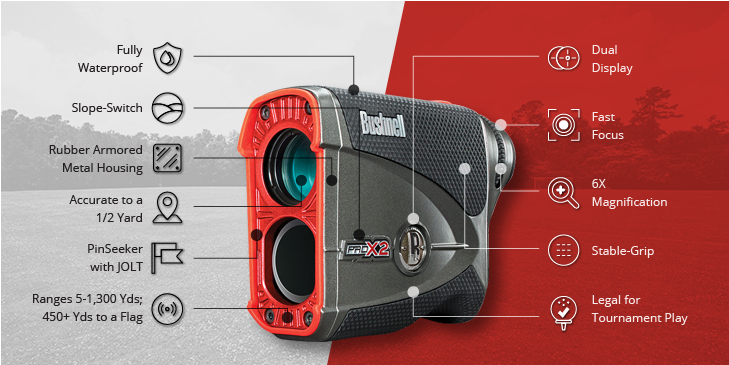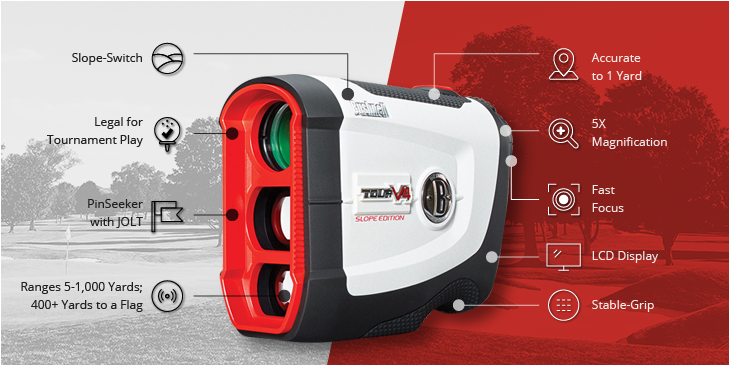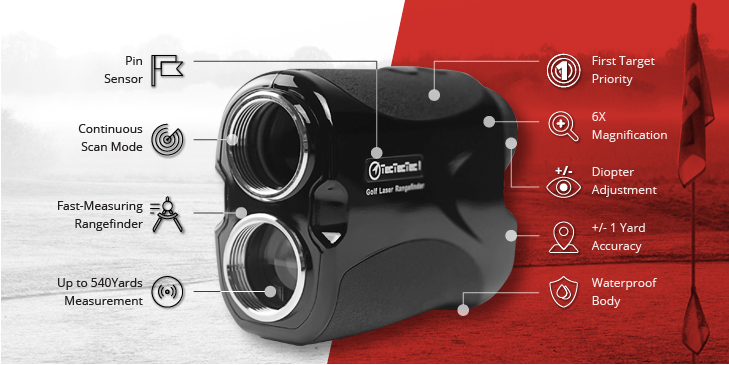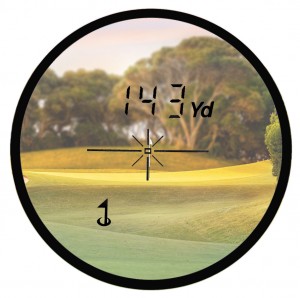After testing dozens and sifting through thousands of reviews of the best golf rangefinders on the market, here are my picks –
Bushnell Pro X2 – The best rangefinder on the market
Bushnell Tour V4 – The best value rangefinder on the market
TecTecTec VPRO500 – The best cheap rangefinder
What makes a great rangefinder?
If you’re in the market for a rangefinder, you want an accurate way to determine distances on the golf course.
If you golf like we golf, you may be looking for the distance to the fairway… from the woods. If you’re a better golfer than we are, you might be looking for the distance to the pin, in yards. There are a variety of ways to determine these distances.
Besides distance to the pin, golfers also want to know:
- Distance to a bunker
- Distance to a water hazard
- Distance to the front of the green
A rangefinder is one of the easier ways to improve your golf game. Why? Well knowing accurate distances goes a long way in helping with club selection. Sure, it might not help your swing, but knowing the right club to use out on the course provides an advantage.
If you are one of those golfers that practices, you can use a rangefinder to dial in your yardages while practicing at the driving range.
Bushnell Pro X2
If you want the best golf rangefinder on the market, you need to check out the Bushnell Pro X2 Jolt Slope Rangefinder. Yes, it is expensive – it retails for $500 – but it has the features to back up the price.
You will need a really nasty hook to take full advantage of the X2’s insane range. The only golf application I can think would require this type of range is seeing how far away the beverage cart is.
It can lock on to the flag from up to 450 yards away, which is handy for when you are thinking about driving the green.
The viewfinder offers 6x magnification, the product is fully waterproof, and there is a limited 2-year warranty.
The Pro X2 will give you a measurement with a precision of up to half a yard.
Feeling the Jolt
If you have used a laser rangefinder you know one of the main drawbacks is the uncertainty about what you are actually measuring. Are you measuring the distance to the flag or something behind the green instead.
To eliminate that uncertainty, Bushnell uses “Jolt Technology”. When the rangefinder does lock on the flag, you will feel a slight vibration in the unit to tell you that you are getting the correct measurement.
Instead of measuring two or three times to confirm your number, you can just measure once, feel the Jolt, and move on with your shot.
Get a Good Look
The Bushnell Pro X2 has “Vivid Display Technology”. This means an MBA found a fancy way to say the viewfinder has improved brightness and resolution.
Slope Calculations
In addition to measuring basic distance, this model can adjust your yardage automatically to factor in the effect of any changes in slope.
So, if the shot you are measuring is going to be played uphill or downhill, the Bushnell Pro X2 will make the necessary adjustments to the number and provide you with a distance needed to hit the target successfully.
Waterproof Design
The Bushnell Pro X2 is designed to be fully waterproof.
[wpsm_column size=”one-half” position=”last”][wpsm_cons title=”CONS:”]
- Price, no matter how you look at it this is a lot to drop on a golf toy
[/wpsm_cons][/wpsm_column]
[wpsm_button color=”red” size=”medium” link=”http://amzn.to/2F6sc1O” icon=”none” class=””]See More Reviews[/wpsm_button]
The Best Rangefinder for the Value – BUSHNELL TOUR V4
It’s was tough to put two Bushnell devices at the top of this list, but they are the top dog in the rangefinder business.
The Bushnell Tour V4 is among their best models, with a price tag that usually comes in right around $300.
One of the great features of this model, and many others in the Bushnell line – is the ‘Pinseeker’ technology. When the laser catches onto the flag, this system will quickly vibrate the unit, telling you that you have found the target successfully. Also, you can use this unit to measure up to 1,000 yards, and the viewfinder features 5x magnification. Simply put, this is among the top rangefinders on the market today.
Features:
- JOLT technology (jolts when you lock onto a pin)
- Can switch in and out of slope mode
- Dimensions: 3.11 x 1.57 x 4 in
[wpsm_column size=”one-half” position=”last”][wpsm_cons title=”CONS:”]
- Water resistant, NOT waterproof. But really when will you need a waterproof rangefinder?
[/wpsm_cons][/wpsm_column]
[wpsm_button color=”red” size=”medium” link=”http://amzn.to/20M6OP6” icon=”none” class=””]See More Reviews[/wpsm_button]
The Best Rangefinder for the Money – TecTecTec VPRO500
This rangefinder boasts measurements to within 1 yard from up to 550 yards away with excellent 6x magnification, kept clear and in focus through incredible performance from its optics.
If you are budget-minded and want to keep the purchase price on your rangefinder to a minimum while still getting a quality piece of gear, the TecTecTec VPRO500 is worth careful consideration.
Smart Savings
Saving money is nice, but buying cheap crappy golf gear sucks.
The VPRO500 does not have all of the bells and whistles of the top-line rangefinders but it will give you accurate yardage from your ball to the target, which at the end of the day is the main feature golfers are looking for in a rangefinder.
Compact Design
With a total weight of just 185g, you won’t be adding anything noticeable to your bag. The rangefinder is designed to be dust and water resistant, and it can easily be used with a single hand. With just a little practice, you will be able to pick this unit up, measure your target quickly, and put it back down to proceed with your shot.
Money Back Guarantee
TecTecTec may not be a brand you have learned to trust. To help with this, the company offers a 100% money-back guarantee. If you aren’t happy with your purchase for any reason, the unit can simply be returned for a full refund. With this protection in place, it is much easier to try out a model that comes from a brand which isn’t as well-recognized as some of the others on the market.
Features
- Compact design – 104x72x41mm
- Lightweight – 185g
- Pin sensor technology for measuring objects that overlap (golf flags, trees or hazards)
- Accurate to within 1 yard over a 500-yard distance
[wpsm_column size=”one-half” position=”last”][wpsm_cons title=”CONS:”]
- Lens fogs up on occasion
- Sometimes struggles to lock onto the pin
- Only available in black
[/wpsm_cons][/wpsm_column]
[wpsm_button color=”red” size=”medium” link=”http://amzn.to/1TNPf0z” icon=”none” class=””]See More Reviews[/wpsm_button]
What Type of Distance Finder is Best?
There are a handful of solutions available on the market. Which golf distance finder is best for you, is up to your personal preference.
GPS Devices
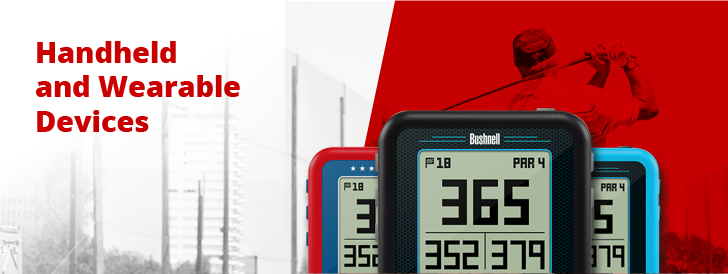
There are a couple of popular types of GPS devices on the market. I break them down into two categories Handheld Devices and Wearable. They all essentially serve the same purpose with the difference being how the course details are displayed and how you carry them around with you. Handheld devices can be carried in a pocket or on the golf cart whereas wearables like a GPS Golf Watch are worn on your wrist or wearables like a Skycaddie may be worn on the brim of a hat.
Click here to see a break down of Rangefinders vs GPS Devices
Smartphone Apps

Similar to Google Maps or other navigation apps on your smartphone, there are GPS Golf Apps which allow you to gauge the distance to the pin or course features using the builtin GPS on your iPhone or Android device. Are you looking for the cheapest option? The cheapest form of golf rangefinder is a smartphone app.
Click here for more on rangefinders vs apps.
Laser Rangefinders

Typically what people think of when they hear golf rangefinder are laser rangefinders. These look similar to binoculars. You use an eyepiece to aim a laser at the object you want the yardage to. These devices are typically more accurate than GPS Devices and Smartphone apps but are also more difficult to use.
Click here for all of my rangefinder reviews.
What to Consider when Buying a Rangefinder

For more info on what to consider when buying a rangefinder, click here.
History and Legality of Rangefinders

The Rules of Golf are often slow to permit the use of new technologies, such as rangefinders. While laser rangefinders have been used for many years in a variety of applications – such as hunting, – they are relatively new to the world of golf.
Traditionally, there were a couple of ways to obtain yardage on the golf course. The first was through markings on the course such as on the cart path, sprinkler heads, and more. For years, it was common to see players ‘walking off’ the distance between one of these markers and their ball in order to get a yardage. While this system worked fairly well, it is time-consuming and something of a hassle. Also, depending on the ability of a given golfer to pace off their yardage, the final number that is determined may or may not be entirely accurate.
When the rangefinder arrived on the scene, all of that changed. Rather than pacing around the course, players were now able to obtain an extremely accurate (in most cases) yardage within just a fraction of a second.
However, there is a small point that most golfers do not understand – rangefinders are still illegal under the rules of golf. Despite the fact that they are commonly seen on golf courses all across the country, rangefinders are disallowed under Rule 14-3 which restricts the use of ‘any artificial device or unusual equipment for the purpose of gauging distance or conditions which might affect play’.
Why are rangefinders still around if they’re banned?
So how are so many people using rangefinders when they are explicitly ruled out in the Rules of Golf? In 2006, the USGA allowed for the use of a Local Rule which can permit the use of distance measuring devices, as long as they only measure distance (not slope, wind, etc.).
When the Local Rule is in effect, players can freely use their distance-only rangefinders without penalty. Models that include slope or other features are always illegal under the rules, no matter what kind of Local Rule is put in play.
If you are playing a casual round with your friends, feel free to use your rangefinder to obtain all of the distances you need. However, if you are playing in a tournament, you will need to check to ensure that the Local Rule regarding rangefinders has been put into use. Most tournaments do allow them to be used, but it is smart to double-check anyway before you head to the first tee.
On the PGA Tour, the Local Rule has not been adopted, so players at that level are not able to use rangefinders during competition. They do, however, use them in practice rounds to record important yardages for use later.
Off-Brand Rangefinders
When shopping for any product – such as if you’re on the lookout for the best mallet putter or anything else – there is always the temptation to buy an off-brand in order to save some money. Nearly every name brand product in existence faces competition from an off-brand imitator who offers to provide the same basic functions for a lower cost. When it comes to rangefinders, is it a good idea to go in this direction in order to save a few bucks? Well, that all depends on your needs, your budget, and more.
First, the basic function of a golf rangefinder is extremely simple – to measure the distance, in yards, between two locations. So, as you stand in the fairway next to your ball, the rangefinder is tasked with measuring the distance between your ball and the flag (or any other object that you are going to use for a target). With that in mind, it might seem like any old rangefinder could do the job. After all, if it can measure distance, that’s the end of the story – right? Not necessarily.
Considerations when finding the best golf rangefinders
You might be able to locate an off-brand rangefinder which can measure distance accurately, but there are other capabilities that need to be considered. First, how durable is the product? You aren’t going to intentionally ‘beat up’ your rangefinder, but it is likely to get knocked around a bit during the course of a round (especially if you walk the course). You don’t want to purchase a rangefinder only to have it break down after a couple of rounds, so durability is a real concern with lesser brands.
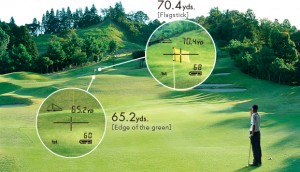 Also, you want to think about the lifespan of the battery included with the rangefinder at purchase. If you are going to have to buy a new battery in short order, you might end up spending just as much money as you would have spent buying a model from a respected brand leader. To determine how long the battery may last in a given model, you can use the reviews found online from previous buyers to gain some insight. If battery life – or any other specific point – seems to be a problem, you might want to think twice about your purchase.
Also, you want to think about the lifespan of the battery included with the rangefinder at purchase. If you are going to have to buy a new battery in short order, you might end up spending just as much money as you would have spent buying a model from a respected brand leader. To determine how long the battery may last in a given model, you can use the reviews found online from previous buyers to gain some insight. If battery life – or any other specific point – seems to be a problem, you might want to think twice about your purchase.
The last thing to think about in this debate is the matter of just how much money you stand to save. Is the savings really going to be worth dealing with a lower quality product? For example, if you are considering two options – a brand name model at $200 and an off-brand option at $150 – is saving $50 enough to make it worth downgrading to a lesser product? Only you can make that choice for yourself, but the answer is often going to be ‘no’ for many golfers. If you are going to bother investing in a rangefinder to improve your experience on the course, it usually will make sense to buy a product from a trusted and respected brand.
Doesn’t the Course Give You Distances Already?
Well, yes, it does. However, those distances have some limitations. First, they are only provided at certain increments – often at 100/150/200. So, if you are around 125 yards from the green, you are going to have to walk 25 yards in either direction to confirm your yardage. Also, those numbers are only measured to the middle of the green, as they cannot take into account the location of the flag on that particular day. While some yardages will be provided on the course, a rangefinder is better.
Getting the Most Out of Your Rangefinder
Generally speaking, rangefinders are quite easy to use. Once you have a little bit of time to get comfortable with the device, you should be able to pick out distances quickly and easily. With that said, there are a few tips we can offer to help you get the most out of owning one of these units. Check out the advice below to make sure you are using your rangefinder to its full potential.
- Measure more than the flag. Sure, you are going to use your rangefinder to obtain yardages to the flag, but you can do much more than that with your laser. Also use your device to measure distances to things like trees, bunker lips, the edge of a water hazard, and more. For instance, if you are playing a dogleg par four and need to know how far to hit your drive, measure a tree on the other side of the dogleg and subtract 10 or 15 yards to come up with a logical number.
- Trust the number. Your rangefinder is going to be far more accurate than your eye. Some players make the mistake of not trusting their rangefinder, instead deciding that the target ‘looks’ like it’s farther away or closer on a given shot. Don’t make this mistake. Trust the technology over your own estimate and hit your shots accordingly
- Use it for a layup. When playing a long par five, you might not think to pull your rangefinder out for measurement on your second shot. However, even if you are going to lay up, it is still worth your time to determine how far you are from the target. The measurement you take can be helpful in deciding how far to hit your second shot in order to set up an easy third. For instance, if you find that you are 320 yards from the flag, and you want to have 100 yards for your approach, you will know that 220 yards is the ideal distance for your second shot.
- Collect a dollar each time a buddy wants the yardage. You pay off the rangefinder in no time.
Check out similar buying guides –
Best Golf Push Carts
Best Golf Training Aids
Best Golf Swing Analyzers
Best Golf Balls for Distance

